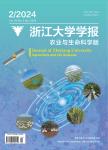Construction of biological control strain of Trichoderma viride and study of their ability to induce plant disease resistance
Construction of biological control strain of Trichoderma viride and study of their ability to induce plant disease resistance作者机构:BiotechnologyInstituteZhejiangUniversityHangzhou310029China
出 版 物:《浙江大学学报(农业与生命科学版)》 (Journal of Zhejiang University:Agriculture and Life Sciences)
年 卷 期:2004年第30卷第4期
页 面:416-417页
核心收录:
学科分类:0710[理学-生物学] 071001[理学-植物学] 07[理学] 09[农学] 0904[农学-植物保护]
摘 要:Plant diseases heavily affct plant growth and crop yield even in modern agriculture. Control its difficult because pathogens mutate frequently, and this leads in frequent breaking of disease resistance in commercial cultivars. The excessive application of chemical pesticides is not only producing pesticide-resistant pathogens, but it is harming the environment threatening the health of human beings. Therefore, the use of biological control agents (BCA) may provide an environmental friendly alternative to chemicals for plant disease control. Hypersensitive response (HR) and systemic acquired resistance (SAR) are the typical expressions of plant defense reactions. Once SAR is established,, the plants exhibits a broad-spectrum of disease resistance against pathogen attack. Researchers have identified elicitor proteins, such as elicitins and harpins, which activate plant defense reactions. It would be useful to explore the possibility of using biological control agents to induce a status of SAR in crop plants. Trichoderma viride is an ubiquitous soil saprophyte and a biological control agent acting by competition for nutrients, antibiosis, and mycoparasitism. If T. viride could be used as a producer and carrier of an elicitor protein, it may be used as a novel BCA specifically active on some plants. To test this possibility, we used cryptogein, a proteinaceous elicitor secreted by Phytophthora cryptogea, to bio-engineering T. viride . The plasmid containing the Crypt gene or its mutated form, was introduced into T. viride genome by using the restriction enzyme mediated integration (REMI) method. The transformed T. viride was able to produce the Crypt protein and to improve disease resistance when the mutants were applied on tobacco plants. In summary our study included: 1. Construction of pCSNTCC and pCSNTCCm plasmids: Crypt gene was mutated by changing the K at position 13 of Crypt into a V (the mutated form was named CryK13V) as described elsewhere. In order allow sec



